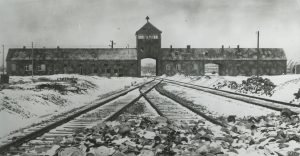Blogpost by Dorothee Alberts
Walking through many European cities today all that reminds us of the vibrant Jewish life and culture that once was part of these cities are small brass cobblestones, so called “Stolpersteine“. These stones are engraved with the name and date of birth and death — if known — of a Jewish person or a whole Jewish family that lived at this place before being killed by the Nazi regime or its collaborators or before being deported and afterwards murdered in one of the countless Nazi-German concentration and death camps.
In Norway these “snublesteiner“ remind us of more than 700 lives lost to the death machinery the Nazis built all over Europe during the 1930s and 1940s. The vast majority of these Norwegian Jewish victims was deported to the infamous concentration camp Auschwitz in one of the most coordinated deportations during the time of the Nazi regime ruling over numerous European countries. Almost all the Norwegian Jews who had not yet fled the country until then were deported to Auschwitz on this day, 26th of November, 1942. More than 550 Norwegian Jews were forced to board the ships DS Donau and MS Monte Rosa in Oslo to be deported to the German concentration camp Auschwitz. All women and children were gassed immediately after their arrival at the camp, as well as those men who were too old or weak to work. Most of the remaining men lost their lives in the years before the liberation of the camp. Out of the 773 Norwegian Jews that were deported to German concentration camps during the time of the Nazi occupation only 38 survived.[1]
It was during the time of the Nazi regime that the Jewish lawyer Raphael Lemkin, who had fled from the Nazis to the United States, defined the term “Genocide“ as a “coordinated plan of different actions aiming at the destruction of essential foundations of the life of national groups, with the aim of annihilating the groups themselves“.[2] After years of international debates concerning his concept it got approved and proposed for signature as part of the “Convention on the Prevention and Punishment of the Crime of Genocide“ in 1948, which entered into force on 12th January 1951, creating the legal basis to prosecute and punish any form of genocidal acts and, ideally, prevent these crimes from being committed in the first place.
However, since then, there have been reports of multiple cases of genocide having been committed, but only few of these cases have been brought to trial in the meantime, such as the Bosnian genocide[3], the genocide against the Tutsi in Rwanda[4] and the genocide against the Yazidis[5]. The cases of genocide that are currently being investigated by experts and activists are numerous, and whilst waiting for the cases to be brought to trial, the survivors and victim’s families are still waiting for justice.
The cobblestones in the streets cannot undo the atrocities committed in the past. However, they can serve as a reminder of what happened when humankind looked in the abyss that was the Holocaust and also may recall that the crime of genocide is still being committed today. They should be seen as a daily reminder to each and everyone passing them to make sure that this will never happen again.
_____________________________________
[1] All figures are taken from: https://snl.no/Holocaust_i_Norge 23/11/2022
[2] Raphael Lemkin: Axis Rule in Occupied Europe. Laws of Occupation — Analysis of Government — Proposals for Redress, Washington 1944, p. 79.
[5] World’s first judgement on crime of genocide against the Yazidishttps://www.amnesty.org/en/latest/news/2021/11/germany-iraq-worlds-first-judgment-on-crime-of-genocide-against-the-yazidis/ 24/11/2022
Photo credits: Museum of Jewish Heritage New York City

